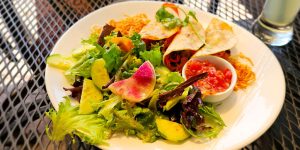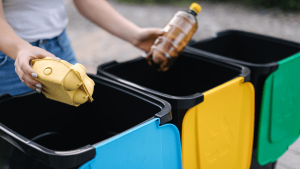The Sweet History of Maple Syrup, Ontario

Advertisement: Click here to learn how to Generate Art From Text
Nothing in Ontario says spring more than the maple harvest. Like the melting of snow, the first crocuses poking their heads above ground, and the singing of early returning robins, it’s a sure sign that the seasons are changing.
In rural Ontario, the harvesting of sap to make delicious syrup from red and silver maple trees is a long-standing tradition. And for many of us, spring wouldn’t be spring without experiencing the sweetness of maple season in some manner – a tour of a sugar bush, delightful maple-inspired dishes, a family-friendly festival celebrating the season.
Mother Nature determines when maple season begins. The sugarbush has to be in a freeze/thaw phase where temperatures are below freezing overnight but warm enough to exceed freezing during the daylight hours. The freezing temperatures cause negative pressure on the tree. In essence, the tree transforms into a vacuum to absorb water from the roots. This water collects sugars in the tree as it enters. During the daylight hours, the warmer temperatures create positive force that pushes water, or sap, to the bottom. When people say the sap runs, they mean this.
When does maple sap run?

This perfect confluence lasts approximately four to six weeks in Ontario, generally from early March until late mid-April.
It is true that European settlers did not invent the practice of collecting maple sap to make sugar. Woodland First Nations had been collecting maple sap for sugar for centuries before white men even arrived on the New World’s shores. Some historians believe that in the distant past, First Nations people cut the bark off maple trees in a desperate effort to avoid starvation following a harsh winter. They were attempting to reach the cambium – the edible part between hardwood and bark. The sap was sweet when the cuts were too deep and penetrated the hardwood. Maple water was thus discovered. First Nations peoples have their own unique stories about what led to the discovery.
When was maple used for the first time in Ontario?
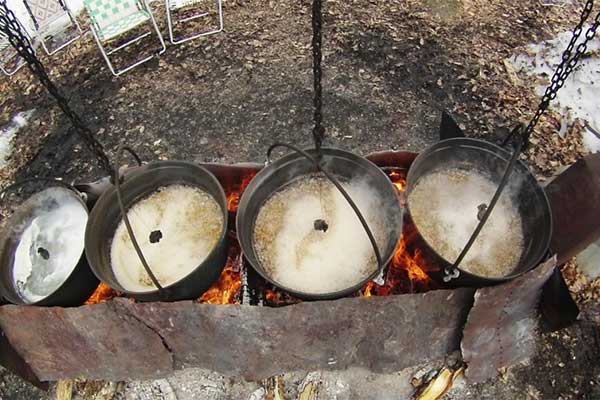
Maple sap was an important part in the First Nations’ culture, no matter how it was discovered. They drank it as a fortifying tonic – modern studies have confirmed what they long knew; that maple sap served as an antioxidant and anti-inflammatory. They also would have used it to cook – Bannock, a sort of unleavened bread used as a provision on long journeys, was made from corn flour, bear fat, and maple sugar.
First Nations’ methods of making maple sugar were relatively crude by modern standards, but ingenious, nonetheless. Blades were used in a slanted manner to gash the maple tree, cutting through its bark and into the wood underneath. In this wound, a wooden chip was inserted along which the sap would leak. It would eventually drip into birch buckets or hollowed out logs lying on the ground. The sap would then be boiled down over a fire in earthenware or by adding red hot stones into a sap filled trough.
Experience the maple seasons through the lens of the First Nations at the Wye Marsh Sweetwater Festival, which is held at Wye Marsh with Sainte-Marie in the Hurons. Enjoy Indigenous storytelling and roast bannock with a stick. Watch historical demonstrations and learn how Huron-Wendats traditionally welcomed spring.
Early European settlers in Quebec as early as 17thThe First Nations of Ontario taught them the value of tapping maples in the nineteenth century. The method used by the settlers to make maple sugar was far more complex than that of the First Nations people. However, it was initially very similar. Gashes were shaped into trees, and a round wooden pipe was inserted into the wood about an inch. Below the sap dripping pails were placed. The sap collected was then boiled in large iron or Copper kettles.
The maple syrup harvesting industry evolved in the 19th Century. In the 1870s metal taps started to replace wood. In 1889, an evaporator was patented and invented in the United States. The evaporator required a substantial investment. Small-scale producers used kettles long after commercial harvesters adopted them.th century.
Harvesting maple sap was an important yearly rite in rural Ontario, an example of typical pioneer ingenuity in using local resources to provide for one’s needs. The sap was used instead of maple syrup, which is rare today. Cane sugar (what we call white sugar today) was expensive at the time because it had been imported from the Caribbean. Maple sugar was a perfect substitute. It is made by hand from the sweet sap of maples in the spring.
Also, settlers used sap for maple butter. The name of the product is a little misleading. There’s no dairy whatsoever in maple butter. Instead, it’s maple syrup that is heated to 100 degrees, quickly cooled, and then whipped into a smooth spread that would be added to cakes or put on bread.
Harvesting maple sap is a laborious and tedious process. It takes 50 gallons to make 1 gallon syrup and it takes 2 or 3 trees to produce this amount of sap in a season. The bush might be covered in wet, heavy snow, and where it wasn’t the ground would be soft mud – in either event, you returned home at the end of the day wet and exhausted. The next day, you went out again.
As the 20th Century dawned, Ontario began to have more sugar available. Maple sap harvesting became rarer and those who did continue to do so did so primarily in order to supply the growing demand for syrup, rather than sugar.
Modern Maple Syrup Production
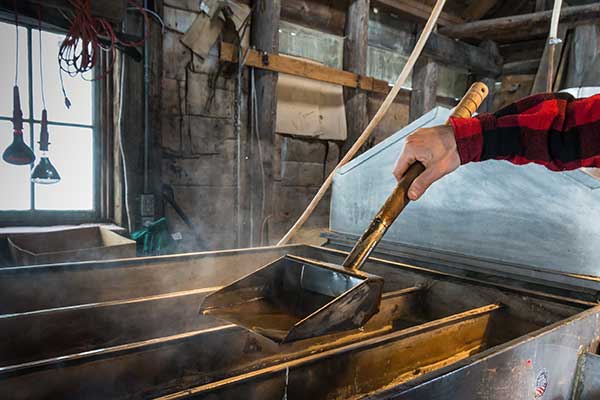
Modern methods of sap harvesting are far different from the days when buckets were manually emptied. Today, hundreds of trees are connected to the sugarhouse by food-grade tubing that runs through the woods. Sap is pumped through the tubes by a vacuum to the sugarhouse storage tanks. Once the sap is collected to the required amount, it’s pumped through a reverse osmosis system that removes approximately 75-80% of excess water. Once the sap is concentrated enough, it will be pumped into an evaporator and turned into maple syrup. The Ontario Maple Regulations state that maple syrup density must be at least 66% sugar. Once the syrup has reached the correct density, it is ready to be packaged.
Experience the harvesting process for yourself Yours Outdoors Maple Magic program – pancakes included!
Celebrate Maple Season with Ontario
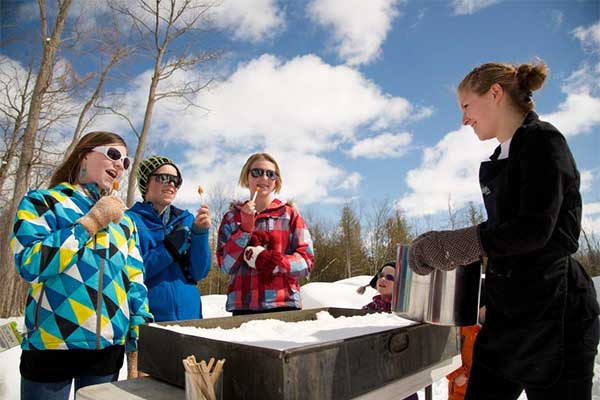
Today, hundreds of Ontario producers continue to enjoy maple season. From the southern tip of Ontario to Thunder Bay, in the northwest, maple syrup is commercially produced everywhere maples are found. Ontario is Canada’s second largest maple syrup producer, behind Quebec. It produces close to one million litres of syrup per year. Maple is usually considered the first agricultural crop for the year.
Many farms offer tours of their sugar bushes and other sweet experiences. One of them is Windlee Farms in MidlandA family-run business that taps 500 trees, and has a store on site.
‘Sugar bush season’ has been increasingly popular. Why not? It’s a great way for you to enjoy local, sustainable agriculture, get out in nature, and shake off the winter. And while a tour of a sugar bush may be a highlight, there are many more experiences to enjoy – maple-themed dining, soothing maple spa treatments, savoring maple themed beer, shopping in quaint shops for maple candles and other novelty items, and more.
Making your own maple-themed memories is easier than ever. Orillia and Lake Country Tourism holds an annual Tap into Maple program, with 20 locations participating. Muskoka also has a similar tour called the Muskoka Maple Trail. It culminates in the Muskoka Maple FestivalHuntsville will be held on April 27th, 2024.
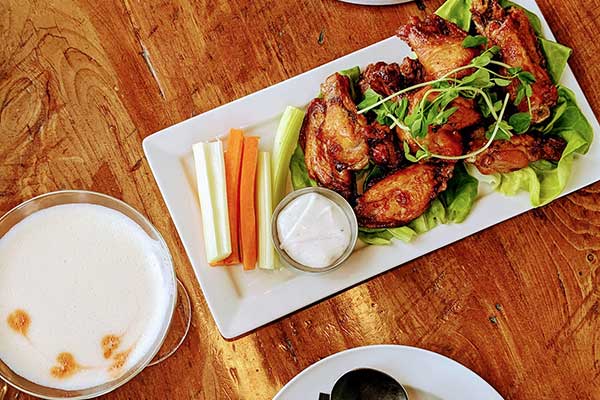
You’ll need a place to rest your head if you plan to make a weekend of your adventures. There are many resorts that celebrate maple season in the region. The region is known for its warm hospitality. Bayview Wildwood Resort, Sherwood Inn, Christie’s Mill Inn and SpaAll three offer maple-themed food. All three are charming, tranquil, and historic – a recipe for a memorable stay.
The culinary team at JW Marriott The Rosseau Muskoka ResortThis resort offers its own maple experiences. JW Marriott The Rosseau features maple-infused spa treatments in its award-winning HydroSpa Muskoka. It also offers maple campfire treats and a sugar tent where you can learn more about the history of syrup production.
Maple sap runs for only a brief window, and so too does the opportunity to savour the bounty of the springtime forest at one Ontario’s varied Maple farmsThe following are some examples of how to get started: maple experiences.
Article written by Andrew Hind.


